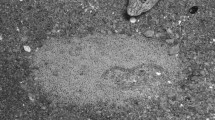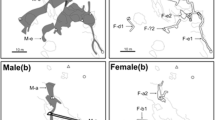Abstract
Reproductive behavior of the threadsail filefishStephanolepis cirrhifer was studied at Kashiwajima, southern Shikoku, Japan. This species spawned in pairs on the sandy bottom, the eggs being scattered over an area of about 15 cm in diameter and attached to sand particles. After spawning, males departed immediately, while the females remained at the site to guard the eggs for a few minutes. Thereafter the eggs were left unguarded for three days until hatching. Females spawned only once daily, whereas males mated with multiple females in succession. The reproductive males established territories, in which 1–4 resident females defended smaller territories from each other. The harem size changed according to some ecological conditions, such as population density. Moreover, the males also mated with visiting non-resident females. Thus, the two alternative tactics of females resulted in two mating patterns, haremic polygyny and female visiting of male territories, in a single population ofS. cirrhifer.
Similar content being viewed by others
Literatute Cited
Akagawa, I. and M. Okiyama. 1995. Reproductive behavior of the filefishRudarius ercodes: male spawning parades and female choice. Env. Biol. Fish., 43: 51–62.
Akagawa, I., Y. Tsukamoto and M. Okiyama. 1995. Sexual dimorphism and pair spawning into a sponge by the filefish,Brachaluteres ulvarum, with a description of the eggs and larvae. Japan. J. Ichthyol., 41: 397–407.
Barlow, G. W. 1987. Spawning, eggs and larvae of the longnose filefishOxymonacanthus longirostris, a monogamous coralivore. Env. Biol. Fish., 20: 183–194.
Fricke, H. W. 1980. Mating systems, maternal and biparental care in triggerfish (Balistidae). Z. Tierpsychol., 53: 105–122.
Fujita, S. 1955. On the development and prelarval stages of the file-fish,Monacanthus cirrhifer Temminck et Schlegel. Sci. Bull. Fac. Agr., Kyushu Univ., 15: 229–234. (In Japanese with English summary.)
Gladstone, W. 1994. Lek-like spawning, parental care and mating periodicity of the triggerfishPseudobalistes flavimarginatus (Balistidae). Env. Biol. Fish., 39: 249–257.
Kawase, H. and A. Nakazono. 1994a. Reproductive behavior of the honeycomb leatherjacket,Cantherhines pardalis (Monacanthidae), at Kashiwajima, Japan. Japan. J. Ichthyol., 41: 80–83.
Kawase, H. and A. Nakazono. 1994b. Reproductive behavior of the flagtail triggerfish,Sufflamen chrysopterus. Proc. 7th Int. Coral Reef Symp., Guam, 905–907.
Kawase, H. and A. Nakazono. 1995. Predominant maternal egg care and promiscuous mating system in the Japanese filefish,Rudarius ercodes (Monacanthidae). Env. Biol. Fish., 43: 241–254.
Kuwamura, T. 1988. Parental care and social systems in fishes. Kaimeisha, Tokyo. 136 pp. (In Japanese.)
Matsuura, K. 1984. Tetraodontiformes. Pages 357–366, pls. 321–334in H. Masuda, K. Amaoka, C. Araga, T. Uyeno and T. Yoshino, eds. The fishes of the Japanese Archipelago. English text and plate. Tokai University Press, Tokyo.
Nakazono, A. 1979. Studies on the sex reversal and spawning behavior of five species of Japanese labrid fishes. Rep. Fish. Res. Lab., Kyushu Univ., 4: 1–64. (In Japanese with English summary.)
Nakazono, A. and H. Kawase. 1993. Spawning and biparental egg-care in a temperate filefish,Paramonacanthus japonicus (Monacanthidae). Env. Biol. Fish., 37: 245–256.
Nakazono, A., H. Takeya and H. Tsukahara. 1979. Studies on the spawning behavior ofChromis notata (Temminck et Schlegel). Sci. Bull. Fac. Agr., Kyushu Univ., 34: 29–37. (In Japanese with English summary.)
Nelson, J. S. 1994. Fishes of the world. 3rd ed. John Wiley & Sons, Inc, New York. 600pp.
Ochi, H. 1986. Breeding synchrony and spawning intervals in the temperate damselfishChromis notata. Env. Biol. Fish., 17: 117–123.
Thresher, R. E. 1984. Reproduction in reef fishes. T. F. H. Publications, Neptune City. 399 pp.
Author information
Authors and Affiliations
About this article
Cite this article
Kawase, H., Nakazono, A. Two alternative female tactics in the polygynous mating system of the threadsail filefish,Stephanolepis cirrhifer (Monacanthidae). Ichthyological Research 43, 315–323 (1996). https://doi.org/10.1007/BF02347603
Received:
Revised:
Accepted:
Issue Date:
DOI: https://doi.org/10.1007/BF02347603




